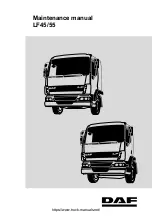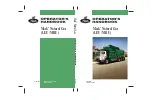
C A B A N D BO DY M O U N T IN G S 1-73
though the proper amount of refrigerant is in the
system. Air inlet temperature must be 70°F ., or
above to make an accurate check. In no case should
the system be charged with more than 3-1/4 lbs.
of refrigerant.
8. When refrigerant has been injected, con
tinue to operate system and test for proper oper
ation as outlined under "Performance Testing."
9. When satisfied that air conditioning system
is operating properly, stop engine, remove gauge
set and replace protective caps on compressor
fittings.
C A U T IO N : A considerable amount
of refrigerant will collect in the high
pressure line, since some of this re
frigerant will have condensed into liquid
refrigerant. Wrap the high pressure
gauge fitting at the compressor with a
shop cloth before disconnecting the
Schrader valve from the gauge fitting,
to prevent injury to personnel.
10.
Using leak detector J-6084, check com
plete system for leaks, as explained later under
"Checking For Leaks."
R E FRIGERA N T- 12 DISPOSABLE C A N M E T H O D
After having depressurized, repaired (if neces
sary), and evacuating the refrigerant system, the
system may be charged as follows when using Re
frigerant-12 disposable cans:
1. Obtain five "one"pound cans of Refrigerant-
12
.
2. Mount four cans in J-6272-01 No. 4 Multi
opener or attach J-6271 Fits-All valve (single can
opener valve) on one can.
C A U T IO N : Make sure outlet valve
on opener is closed (clockwise) before
installing opener.
a. If the J-6272-01 No. 4 Multi-opener is used,
raise locking lever, position four cans of refrig
erant and force the locking lever down to secure
cans and at the same time puncture the top of the
can to make it ready for charging.
b. If the J-6271 Fits-All valve is used, back
off the valve from the can top retainer, slip the
valve on to the can and turn the valve into the re
tainer until tight. D O N O T open outlet valve during
this operation as turning the valve into the retainer
punctures the top of the can to make it ready for
charging.
3.
Connect center flexible line of gauge set to
the fitting on a can opener valve.
N O T E : If line at center gauge fitting has not
been purged of air, loosen line at center fitting on
gauge set and "crack" valve at can opener (for a
second or two) to force air fromtheline. Retighten
line at center fitting.
4. Open valve on No. 4 Multi-opener (or on
single can) and also low pressure and high pres
sure valves on manifold gauge set. Leave can valve
open until all refrigerant has entered the refrig
eration system. Close valve on can.
a.
If the system is charged using single cans
and the J-6271 valve, disconnect valve from can,
leaving valve closed to flexible line to the center
fitting of the manifold gauge set. Install valve on a
new and full disposable can of Refrigerant-12, and
repeat until three and one quarter ”one-pound"
cans of refrigerant have been used to charge the
system. The system requires 3-1/4 pounds of re
frigerant to have a proper charge. (Actually the
net weight of refrigerant is 15 ozs. per can, there
fore it will be necessary to use 3-1/2 to 4 cans. In
no case should the system be charged with more
than 3-1/4 pounds of refrigerant.)
If the J-6271 Fits-All valve for single cans is
available, complete charging as explained in 4a
previously.
5. Close valves on manifold gauge set.
6. Operate engine at 2000 rpm with " T E M P ”
control knob at full cold position and blower con
trol for high speed with "A IR " knob in "O U T S ID E "
position.
N O T E : If air inlet temperature at the con
denser is below 70°F ., when this check is made,
bubbles may appear even though the proper amount
of refrigerant is in the system. Air inlet temper
ature must be 70°F ., or above to make an accurate
check. In no case should the system be charged
with more than 3-1/4 pounds of refrigerant.
7. When refrigerant has been installed, con
tinue to operate system and test for proper oper
ation as outlined previously under "Performance
Testing.”
8. When satisfied that air conditioning system
is operating properly, stop engine, remove gauge
set and replace protective caps on suction and dis
charge fittings.
C A U T IO N : A considerable amount
of refrigerant will collect in the high
pressure line, since some of this re
frigerant will have condensed into liquid
refrigerant. Wrap the high pressure
fitting at the compressor with a shop
cloth before disconnecting the Schrader
valve from the gauge fitting to prevent
damage or injury to personnel.
9.
Using leak detector J-6084, check complete
system for leaks as explained later under "Check
ing For Leaks.”
CHEVROLET SERIES 70-80 H EAVY DUTY TRUCK SH O P M A N U A L
Summary of Contents for 70 1969 Series
Page 1: ...CHEVROLET HEAVY DUTY TRUCK SHOP MANUAL...
Page 3: ......
Page 11: ...LUBRICATION 0 4 CHEVROLET SERIES 70 80 HEAVY DUTY TRUCK SHOP MANUAL...
Page 27: ......
Page 119: ......
Page 361: ......
Page 371: ......
Page 427: ......
Page 443: ......
Page 451: ......
Page 493: ......
Page 499: ......
Page 549: ......
Page 555: ......
Page 609: ......
Page 715: ...am...
Page 745: ......
Page 910: ......
Page 913: ......








































